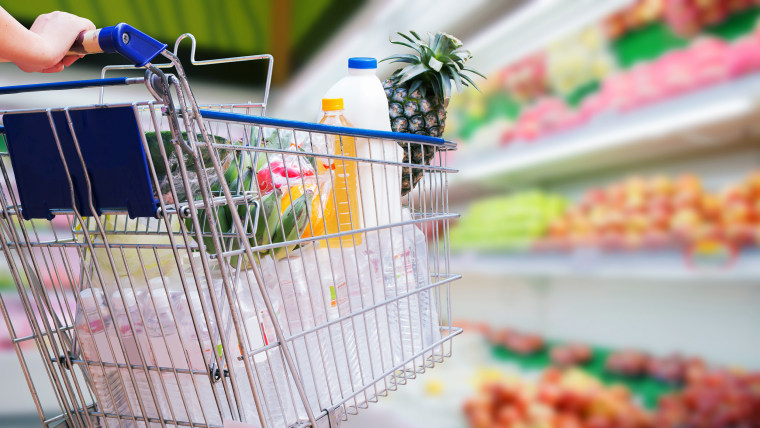We love our supermarkets, but with microbes piggybacking on produce and multiplying in meat cases, you might be bringing home more than groceries when you shop.
We asked Dr. Charles Gerba, professor of microbiology and environmental sciences at the University of Arizona (his nickname is Dr. Germ), to reveal the dirty details on the top germy things in supermarkets. You may be surprised to learn that something you bring in with you may be among the germiest items of them all. Here are the 10 germiest things and places in your grocery store, with tips on how to protect yourself.

1. Shopping cart handle
Since 80 percent of germs are transmitted with our hands, it makes sense that shopping cart handles are covered in bacteria. “The first thing I do is wipe the handle,” says Gerba. Take advantage of the sanitizing wipes at the entrance to the store and do the same, or carry your own wipes.
RELATED: The 5 germiest places in your kitchen — and how to clean them
2. Shopping cart child’s seat
Drippy noses, drooling mouths and leaky diapers — kiddies leave behind some interesting stuff . “I wipe down the place where the kid’s bottom goes because that’s where I put the fruits and vegetables,” says Gerba. So, whether you're putting a tot or a purse on it, wipe down the child’s seat.
RELATED: The 6 germiest places in a restaurant
3. Produce aisle
Remember the stat about hands spreading germs? Nowhere does this come into play more than in the fresh produce section. “I don’t know anyone who buys produce without squeezing or touching it,” says Gerba. Cuts or tears in produce provide an open door for germs to enter, so Gerba recommends choosing produce that is not cracked, split or opened in some way. While you're in the produce aisle, pick up some extra plastic baggies — you'll need them for No. 4.
RELATED: The best times to go grocery shopping — and the worst
4. Meat and seafood counters
When selecting meat, poultry or seafood, only choose packages that are cool to the touch. If the packaging is torn or leaking, don’t buy it, says Gerba, because germs can enter through those openings. He also advises double-bagging these items before placing them in the cart, and keeping them separate from produce to avoid cross-contamination.
5. Canned and boxed goods
NSF International, a public health and safety organization, advises shoppers to check all canned and boxed goods for damage. Never buy swollen, leaking or damp cans — that can be a sign that the product is contaminated with bacteria, including the Clostridium botulinum that causes botulism. Also, avoid products with rips or punctures in packaging. These are gateways for germs. According to Gerba, as long as the packages aren't damaged, most canned and boxed goods should be safe, though he does recommend wiping the tops of canned goods before opening them.
RELATED: How to spring clean your fridge
6. Self–checkout touch screens
A disturbing 50 percent of self–checkout touch–screens had fecal bacteria and some had MRSA (Methicillin-resistant Staphylococcus aureus, a staph bacteria that is resistant to many types of antibiotics normally used to treat staph infections) too, according to Gerba. “There are actually more antibiotic–resistant bacteria on these screens than in a hospital,” he says. If you like to DIY, make sure to use hand sanitizer after you finish checking out.
7. Credit card screens
Payment screens for credit and debit card purchases require input from a stylus or your finger. In either case, people probably do not wash their hands before using these, so there’s a good chance the same kinds of germs that are on the self-checkout touch screens are also setting up house on payment screens.
8. Restroom faucet handle
You turn on the bathroom faucet with germy hands, then turn it off with newly cleaned hands. Result: you might be leaving the bathroom germier than when you entered it, with nasties like salmonella and E. coli on your hands. Use a paper towel to turn off the faucet, then use it again to open the door when you leave. If the restroom also has hand sanitizer, play it safe and use it on the way out, Gerba adds.
9. Reusable bags
Here's the germy thing you might be bringing with you: Reusable bags, if not washed between uses, may be among the germiest items you come in contact with in the supermarket. "The poultry drippings, leaking milk and left–behind produce have nothing to do but breed germs between trips to the market, especially when sitting in a warm trunk," says Gerba.
NSF International recommends washing reusable bags in soap and water after each use. It also suggests marking bags by product type — bakery, produce, meat, etc., to avoid cross–contamination. “Don’t use shopping bags for dirty gym shoes or workout clothes, either,” adds Gerba. “Who knows what you’re introducing into the bags?”
10. Anything you handle improperly
Sometimes shoppers inadvertently turn perfectly good food into a germ-fest by not handling it properly, says Gerba. Keep cold food cool and hot food warm by picking up refrigerated, frozen and hot deli items right before checking out. If it’s going to take more than an hour to get home, NSF International advises consumers to pack raw meat in a cooler — and keep the cooler in the passenger area of the car during warm weather.
One last reminder: "Ditch supermarket germs as soon as you get home by washing your hands or using hand sanitizer," says Gerba. It’s one of the easiest ways to protect yourself and your family.